
Pre-Miramichi Season Salmon Blog
Fishing Friends:
Just returning from salmon fishing in Scotland, with the Miramichi salmon season about to open – I bought my license and guide exemption permit yesterday – and with lots happening on the conservation front, I’ve got plenty of material for a spring Miramichi salmon blog. Let’s start out with the fun part – salmon fishing.
The ghillie for the Kildonan estate on the River Helmsdale in the Northern Highlands of Scotland is John Young. John is perhaps the embodiment of the complete Scottish ghillie. First, he is incredibly qualified as he has been a life-long, hardcore salmon fisher, was the head of Tay River Ghillies Association and loves all of the related Scottish traditions: Spey casting, fly tying, oatcakes, whisky, tweeds, dogs, deer etc etc. Through his efforts John’s anglers catch more salmon each season on the Helmsdale than at any of the other 5 lodges. John sizes you up at the beginning of the week, and if he thinks you are up to it the week is a combination of boot camp and salmon fishing master class. Often it isn’t enough, despite the commonly-strong winds and cold temperatures for your fly to land in the correct spot, but it must land without hitting the water’s surface too hard – even though it is a copper tube. Further, the swing of the fly must be directed by the proper position of the rod tip and augmented by a hand retrieve so that the fly swings through the pool with the exact speed and path that John wants. If you fail – even by a little – he slowly shakes his head back and forth and blankly stares at the ground.
In a week’s fishing there are many chances to get it right. During the month of March in Scotland, the fish of a thousand casts becomes the fish of several thousand casts. Each springer, though, is a sleek, solid specimen that compels serious anglers from all over Europe, the UK and North America to come to Scotland looking for that early fish. I tell people that it is like whitetail deer hunting. You can, even in good country, carefully hunt all week and end up with nothing or maybe that one good shot at a deer, but you consider it a worthwhile trip. The Helmsdale, like the nearby Brora, Thurso, Naver and other Northern Highland rivers is hallowed ground to salmon anglers. While salmon runs aren’t what they were 100 years ago, these rivers still offer good fishing when conditions are right. In September, there are salmon in all of the better pools throughout the system. Getting them to take a fly is the challenge, but the fish are there. In March the fish are fresh from feeding in the ocean, and if you get a fly near one the chances of a take are high. Finding one to present the fly to that early in the season is the challenge. John’s solution to this is hard work.
The Helmsdale has two sections separated by a gorge with waterfall, and each section has 6 beats. At all times the river fishes 12 rods – two to a beat. In March the river is cold, and almost all the fishing is in the river’s lower section. By early April fish are regularly going through the gorge and over the falls and beginning to populate the upper section. Both sections are more or less the same 6-mile distance long as the crow flies. The distances along the river’s heavily oxbowed course that must be walked are much, much longer, and in the upper section the river is often located hundreds of yards from the road across some very difficult walking with soggy peat lands, ankle-twisting, grass-tussock festooned ground and steep hillsides.
The first fish I connected with on my recent trip was from a ledge perched above a pool in the gorge called The Flats. Most fish are caught when the fly lands by a particular set of rocks across the pool – not a long cast – and then is slowly retrieved across the lip where the pool spills downward to the next level. Once on the line, the 12-pound, daisy-fresh springer salmon, still carrying sea lice, had to be kept from going down over the lip – which the salmon have only mild reluctance to do. There is no following them. My fish didn’t try that, but two days later a retired ghillie named Andy Sutherland, brother of Ron the famous local fly tyer, hooked a slightly larger specimen that threatened to go over the lip and down into the river below. Andy had seen this show before and decided to apply whatever pressure was needed to turn the fish back into the pool. It was 50/50 that the hook and 20-pound test Maxima would hold, but it did.

Helmsdale ghillie John Young with a 12-pound Helmsdale springer. The ultimate season’s prize by the account of some salmon fishers.
Friday, two days later, in a howling gale and sideways rain, John had me on the upper river. A chute of fast water poured into a very long, slow, canal-like pool about 40-feet wide, with nearly vertical banks that dropped into about 5 feet of slow-moving water. The flow was all on our side of the river. To put some action on the fly you have to strip, and it is important to angle the cast well downriver, then position your rod tip near the bank to use what little current there is to steer your line and eventually your fly towards the bank where there is flow. The further you could cast the better, since that gave the fly a longer portion of the retrieve when it was fishing in the side of the pool containing the current. There were weeds and rocks on that shallow, far side of the pool, where the fly was to land. That meant the metal tube fly John selected was made of aluminum or aloumineeum as the Brits say it, so that it didn’t get caught up.
To do this successfully you had to overhand cast. Any attempt to roll or Spey cast quickly found the line blown into the tall grass and thorny gorse bushes lining the bank. To further complicate all this John wanted the fly stripped up quite close to your position as often the fish follow it until finally striking at the last minute when the fly approaches the bank. This is all further complicated because the loop-to-loop connections between tips, heads and running lines that are so common with modern Spey lines, are a total pain to strip through the guides. Those of you who are experienced at Spey casting know that when you strip in too far the fat head of the line comes back out through the guides only with difficulty. To defeat that problem, I initially used a water-haul or Snap T cast. John would not accept either of these maneuvers because the line hitting the water might scare fish. John’s solution was an ingenious little cast where he did the motions of a water-haul but did them in the air and not on the water. I nicknamed it the Air-Haul. To the eye it was just a deft, little flick of the rod, you shoot the rest of the head out on the back cast, and the fly miraculously lands in the right position with only a modest splash – sometimes. It took me the rest of the trip to be able to do it myself, but it is a great little trick.
At about 1:30 PM we came to spot where a small point of land and rock stuck out a few feet from our side of the pool. When my fly came by that point, at just the right distance from shore, a chrome colored, mid-teen-size salmon rocketed out from wherever and grabbed my fly. After a couple of immediate jumps and explosive, grey-hounding maneuvers, the salmon ran up the pool beyond me and then back and parked itself directly under my rod tip. I tried putting moderate pressure on the fish from first one side then the other, and finally the salmon ran back where it all began and cartwheeled across the surface for about 10 feet, successfully getting rid of my fly in the process. John looked at me like someone had just drowned due to my negligence. It is so hard to compare this to Miramichi summer fishing – in the good old days – when you would hook three or four salmon in a morning and one or two would just routinely come unhooked, and no one thought much of it.

John Young illustrates his techniques on the most upstream beat of the Helmsdale River where it meanders through desolate moorlands.
That week 12 rods on the river landed 9 fish. We hadn’t arrived until Wednesday – when I caught the fish at The Flat – because our flights for the previous weekend had been canceled due to the fire in London cutting off power at Heathrow. John fished our rod on Monday and Tuesday, naturally catching one on the most seaward beat, beat 1. That gave John’s rods 2 of the 9 for the week and all was wonderful at Kildonan. The second week was met with colder air and brighter skies. The rod catch for the week was two fish for all rods, and John’s anglers weren’t in that elite group.
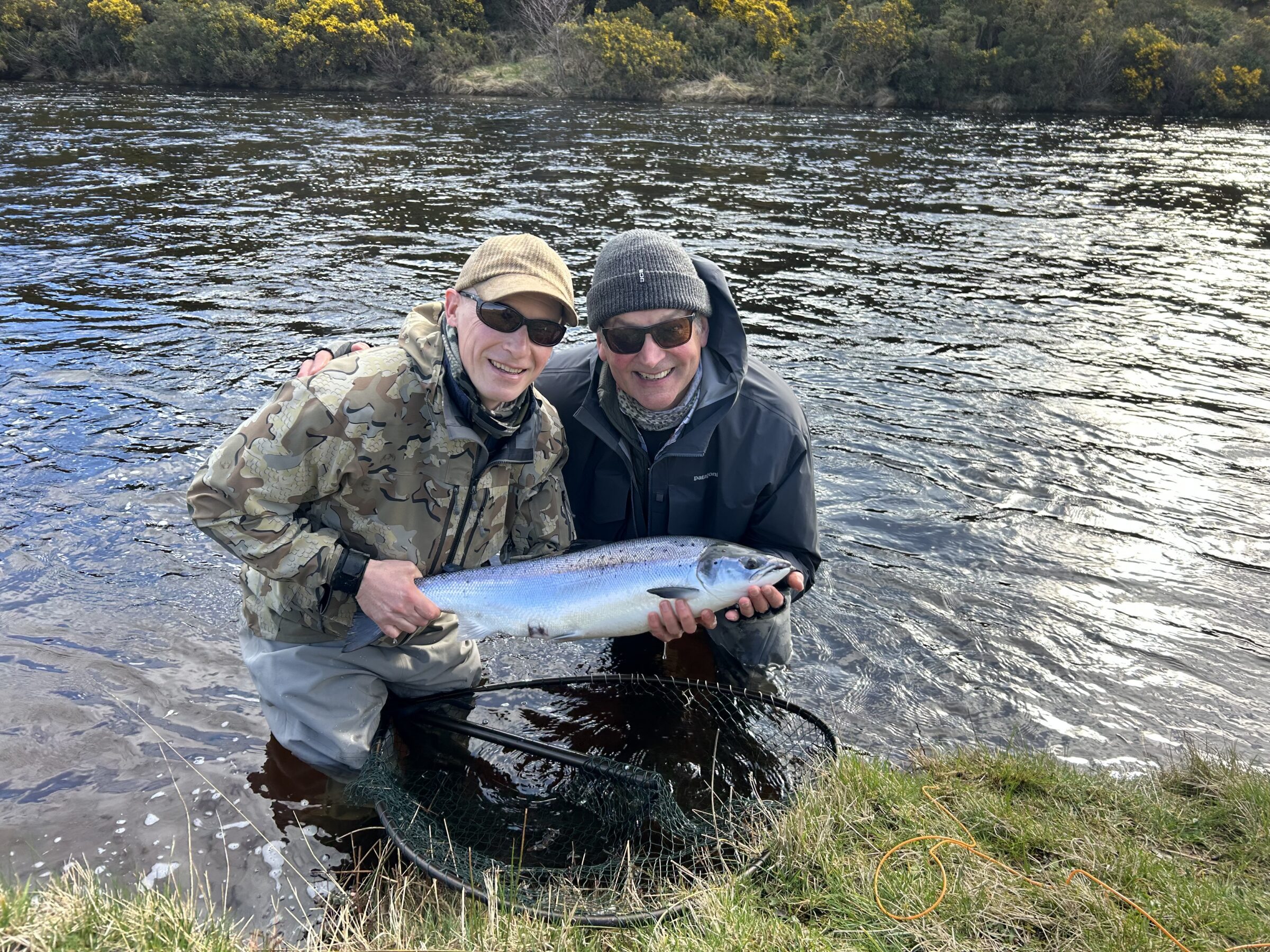
Ghillie Collin and Randal Wilson on the right hold Randall’s springer from a Naver pool called Potato Park.
For next year I’ve vowed to take one of my quick-loading, Rio, Scandi heads and permanently attach it – probably with braided mono – to my preferred Rio Slickshooter running line. All you Spey gurus who read this blog, don’t hesitate to chime in with a better solution if you have it.
On the River Naver which is just a few miles west of the Helmsdale – in fact Loch Rimsdale flows into both the River Mallart, a major tributary of the River Naver, and also into Badanloch the headwaters of the Helmsdale – the action last week was a little better. My friend Randal Wilson, who fished with me on the Naver in early March was back again, and he landed two lovely springers in pools we had fished together three weeks earlier. His fishing partner landed a third.
Before we leave Scotland, I want to treat you to some salmon artistry by my friend Debasis Biswas, better known as DB. My fishing partner George Watson and I first met DB nearly 15 years ago when he was ghillie on the Naver for the Altnaharra Estate. DB, the son of a London surgeon, always had a passion for fish. After getting his master’s in marine science he went north to work in the salmon aquaculture business but couldn’t stand participating in what he felt were injustices against the resource that he loved. We had some great times on the river with DB, but he moved on and now is working on artistic projects that also focus on the wildlife of the Highlands. I would ask you first to have a look at his Facebook page DBWildartmedia. (note that if you have trouble with this link just go to your Facebook page and type DBWildartmedia into the search. It should show up then.) If you see anything you like and want to talk directly to DB, here is his e-mail address: dbnaver@gmail.com.
One of the projects that DB has been passionately pursuing is filming spawning salmon on tributaries of the Naver. Just check out this video that he took last fall. It is incredible and shows you just what those salmon go through. The little underwater bit at the end is from a salmon that DB and I released on the Naver many years ago.
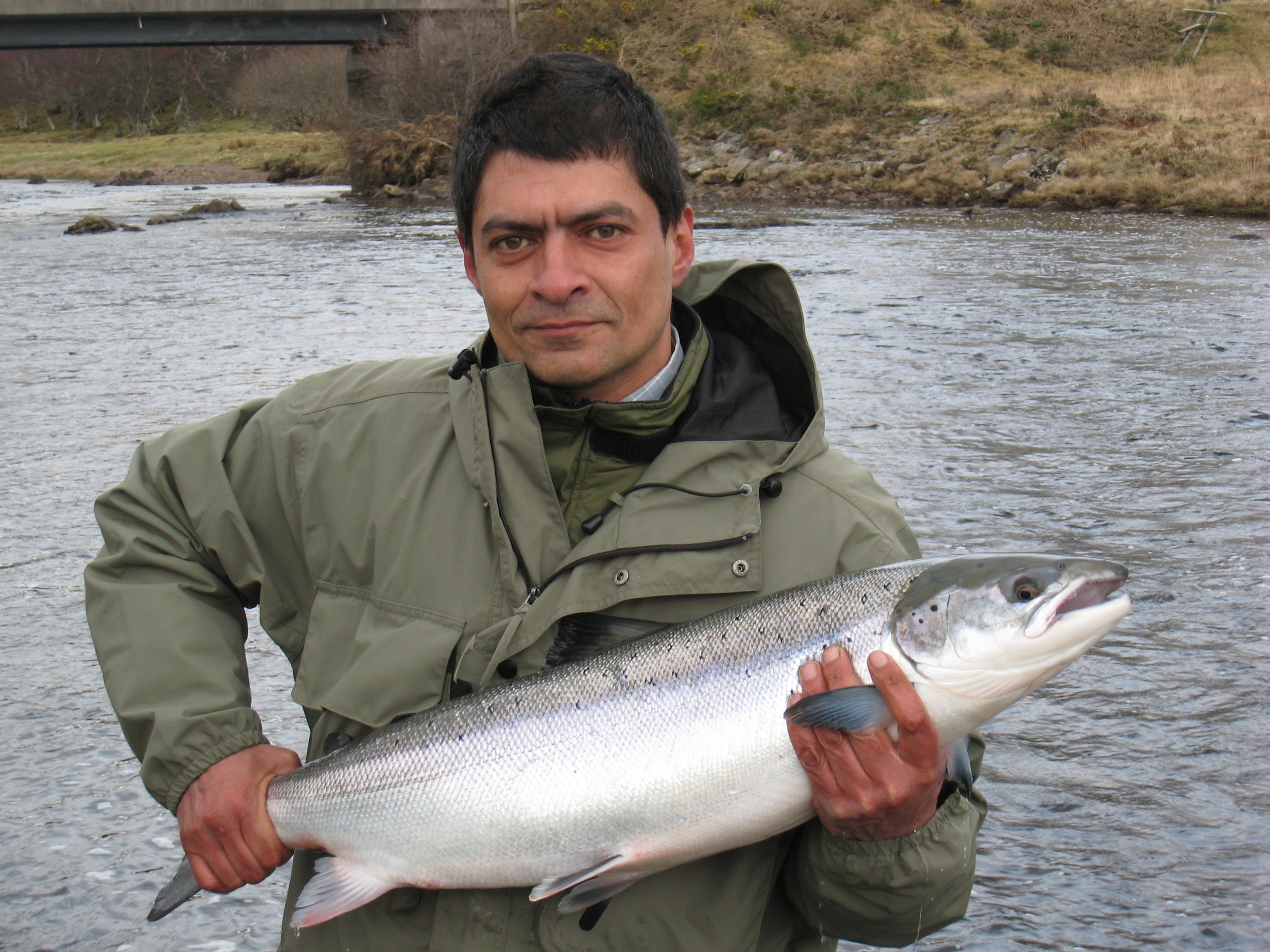
DB holding one of my best Scottish springers from about a dozen years ago at Upper Bridge Pool on the River Naver.
So now for some Miramichi salmon news. The salmon season opens next Monday, April 15. Given the low salmon returns of last fall there is no reason to think that there will be an abundance of kelts in the system, but hopefully there will be enough to make everyone happy. For certain it will be a chance to get out on our great river again and to witness the beginning of another new season. The Environment Canada forecast is only through Monday, but it looks pretty good with a little warming trend forecasting about 50F for opening day with light showers. The water height is at 1.8M now. There are a couple days of showers forecast, so it probably won’t change much. That is a bit on the low side, but actually it’s not a bad fishing height. The water is just a hair above freezing, as it should be, and that is good. I’m packing up my gear now and will be heading up to open camp on the 14th. Darrell Warren is getting the water going and the place thawed out. It will be great to be back.
Of course, the big discussions are all about what we are going to do to dig the Miramichi salmon out of the incredible hole that DFO has put them in. For their part DFO has announced their new salmon conservation policy which has absolutely no specifics about anything. As many of you know, a group called Save Miramichi Salmon LLC has filed a lawsuit against DFO. I can’t be very specific at the moment, but I can tell you that a lot of work is being done by several smart attorneys and several more of the top salmon biologists in the Province.
The MSA, ASF and NBSC and others have spent the last 15 months talking to First Nations about a new salmon management regime for the Miramichi. It isn’t far away from being ready, and then it has to be accepted by DFO and funded by DFO or someone. When I am able to provide more details, I will. While the steps necessary to recover the Miramichi salmon population are not all that complicated, accommodating all the various interests and agendas of these individual groups is not as simple. It’s a lot like national politics, where politicians try to use every bit of leverage possible to further unrelated agendas by attaching things to bills. You wouldn’t think it would be that way with saving Miramichi salmon, but unfortunately with some people it is.
We have to bring striped bass under the level of 100,000 spawning adults to have enough smolts make it out of the river to produce adult returns that will again generate enough smolts etc etc. Naturally, more salmon will make it back to the river if more smolts start down the river. So, we have to stock in addition to lowering the bass. The top experts all agree that both are going to be completely necessary. DFO’s inane policies have just driven the salmon population down too low to recover quickly – or possibly recover at all – without that stocking help. A special task force of volunteer experts has been working on the MSA hatchery. We have hit a snag in the well system that supplies that hatchery water and are working on that. We also need to considerably increase the hatchery budget, not only for equipment, but for everything related – feed, chemicals, energy and more than anything else, staff. It is all being worked on.
The recent developments have taken far too long to come to fruition, and there is still no verification from DFO that they will step up and do what needs to be done, but I do believe that the wheels are grinding forward, and a lot of good people are pushing on the back of this vehicle trying to move it all along.
If you look right now at the Brad Burns Fly Fishing Salmon Report you will see that the last one posted is October 16, the day after the 2024 season ended. I’ll start the 2025 season on April 15 with daily reports and will update them as often as I have information to share. I look forward to your comments on my blog and on the report page whenever you want to make them. I always try to quickly answer any questions. If someone shares this post with you, why not sign up to receive free alerts from me when I make a new Miramichi blog post. Here is the link. I promise no one will get your e-mail address.
Thanks for reading. Brad Burns
A few more photos:
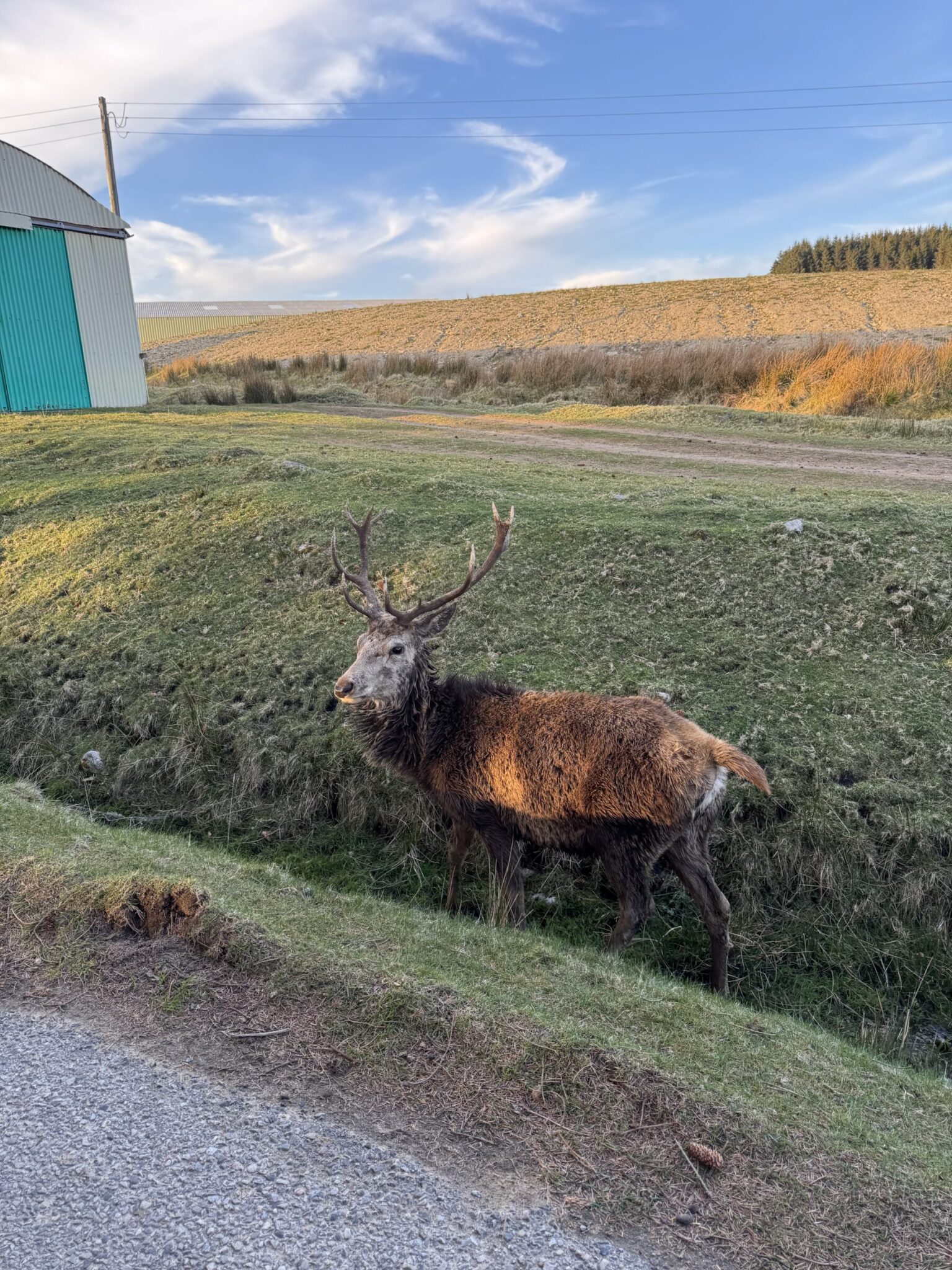
We were invited to dinner one evening by friends at Badanloch Estate, this red stag was feeding in the ditch at the end of the driveway.



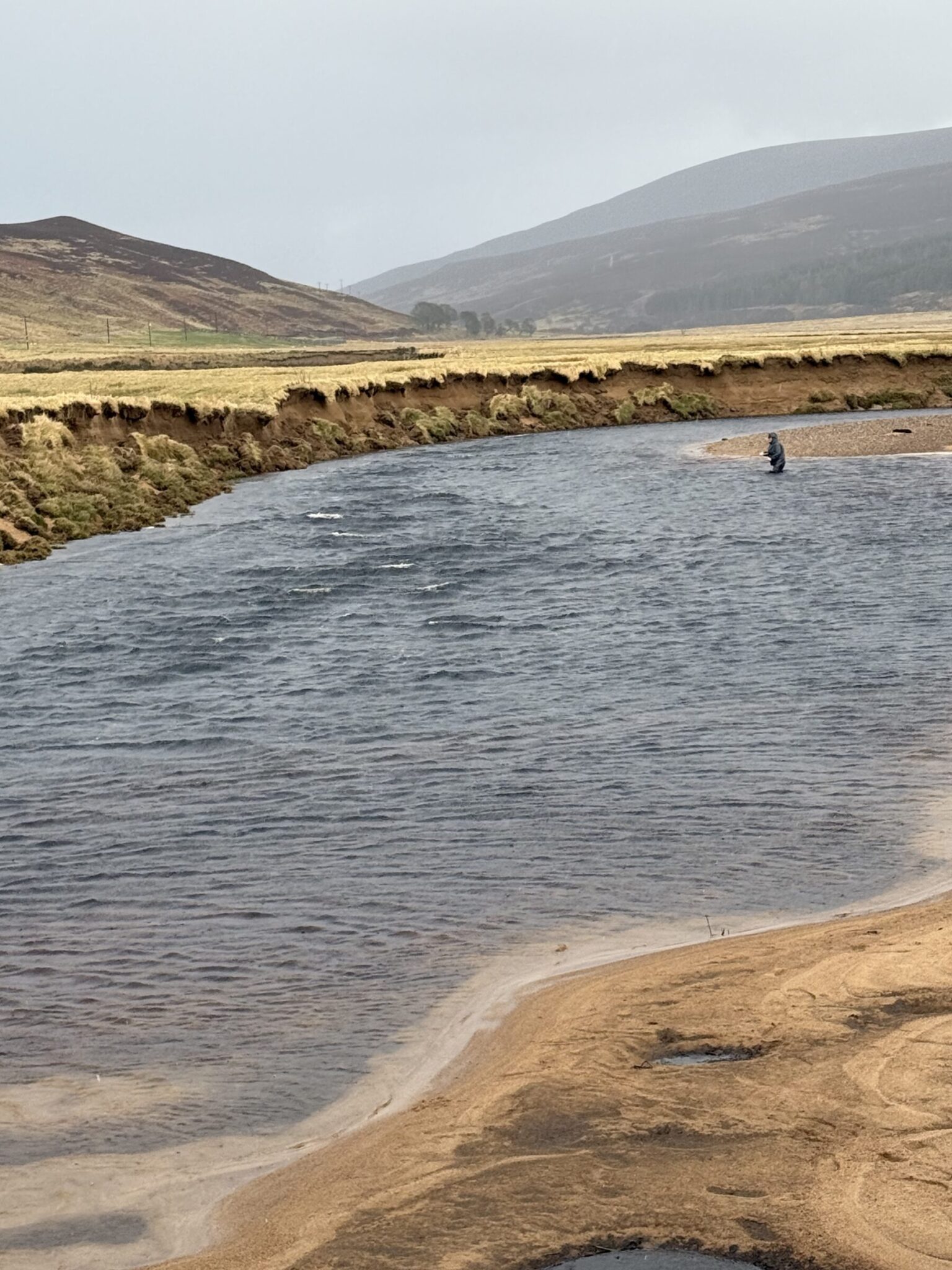
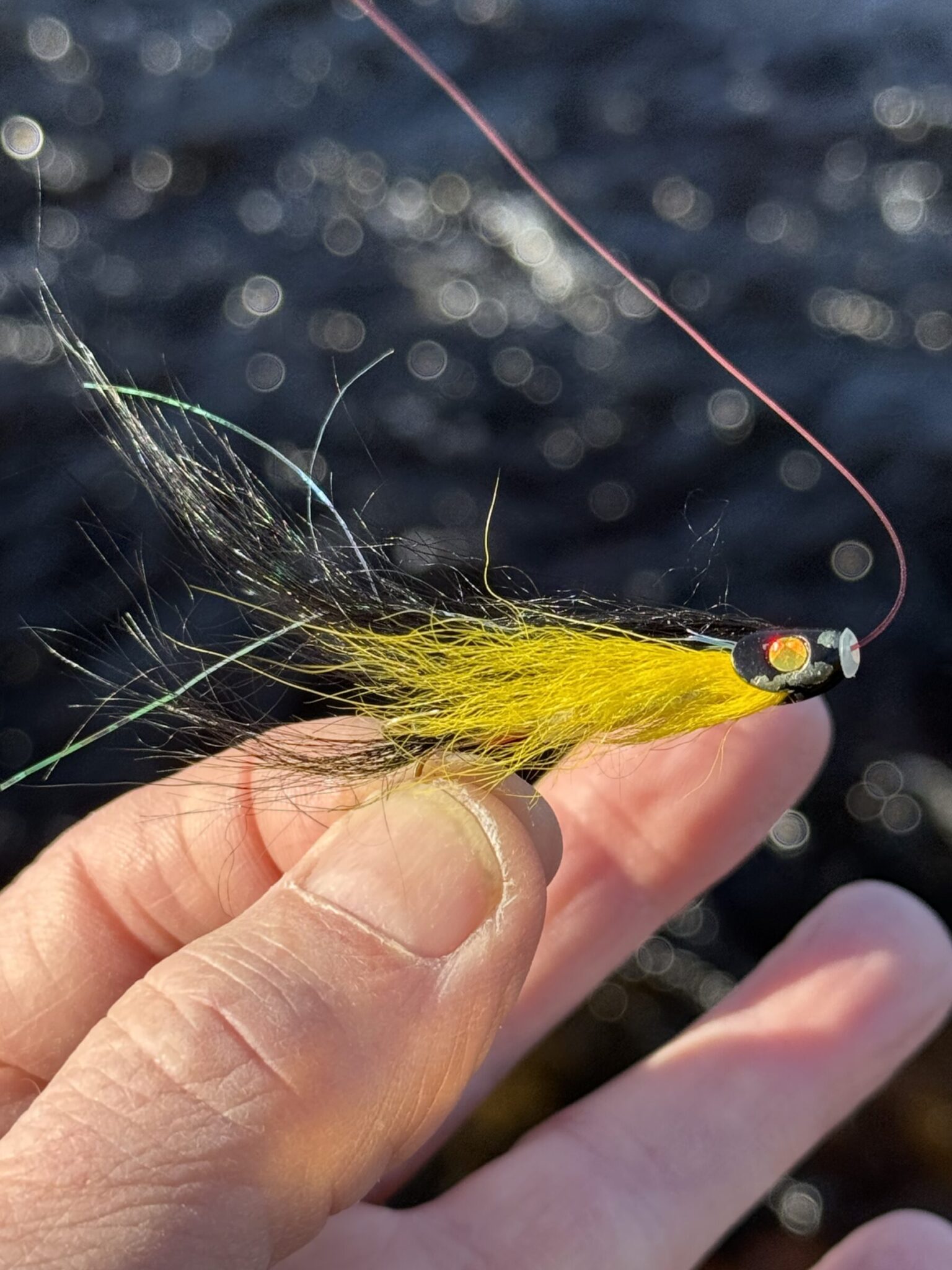

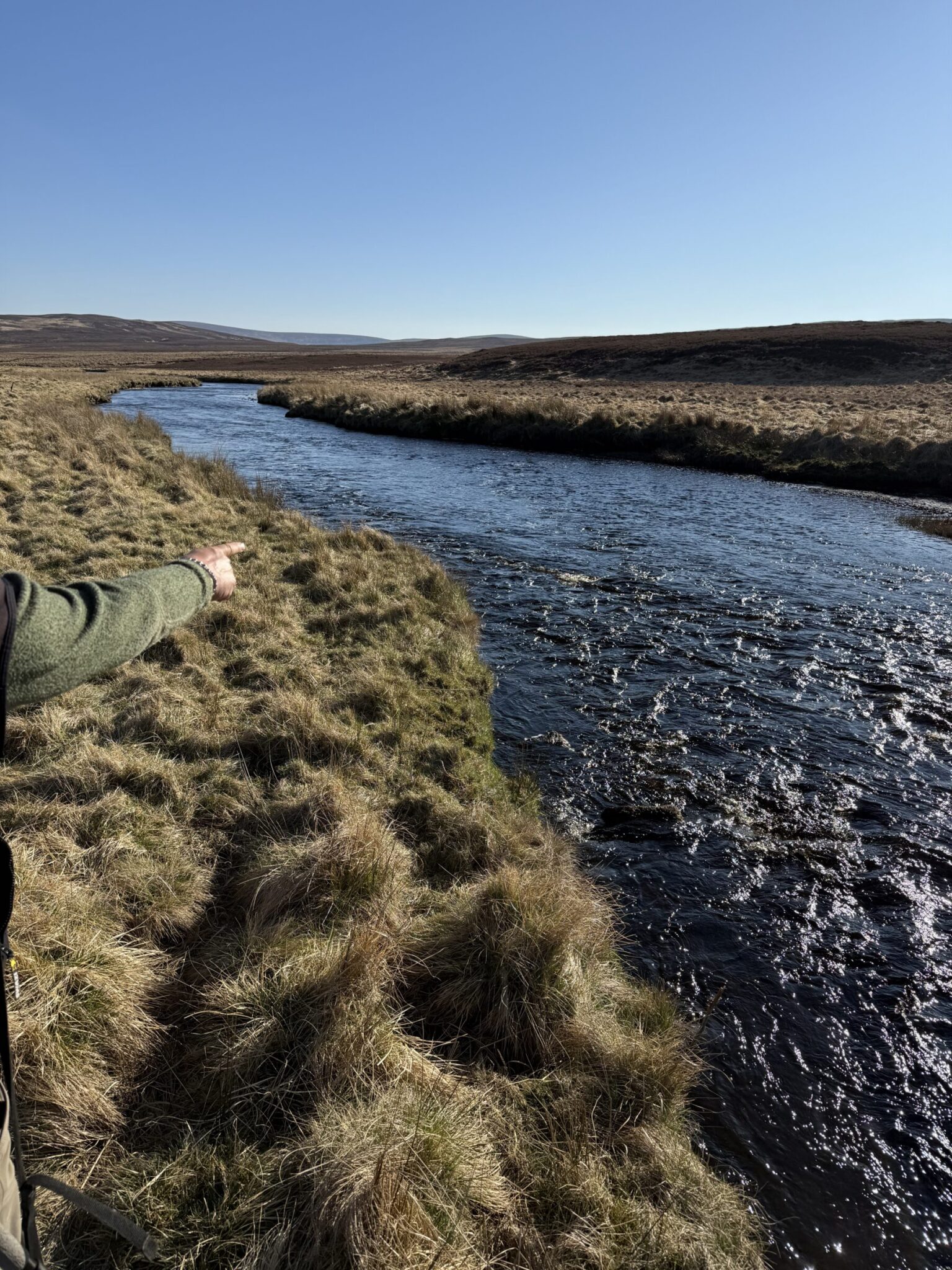
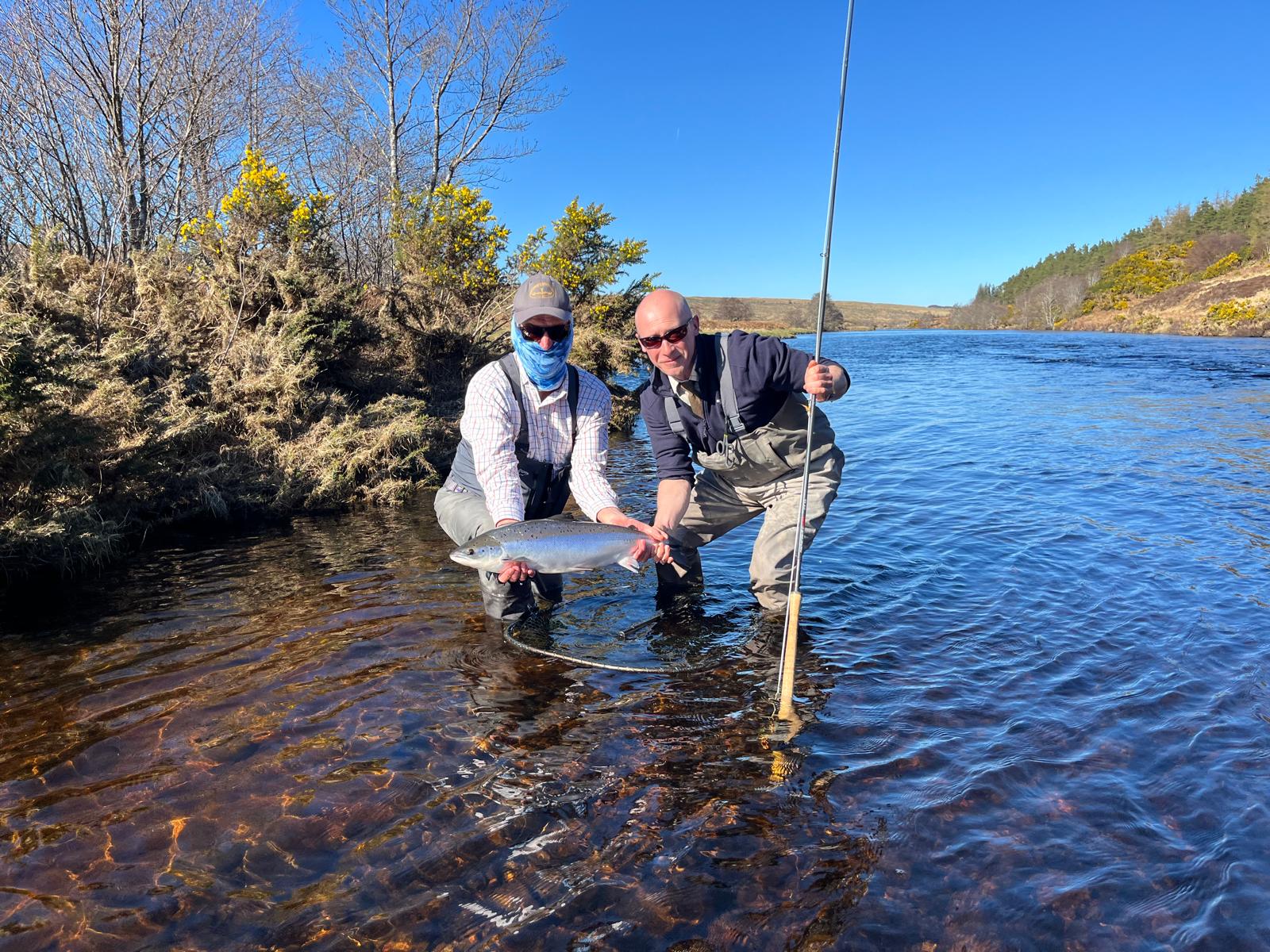
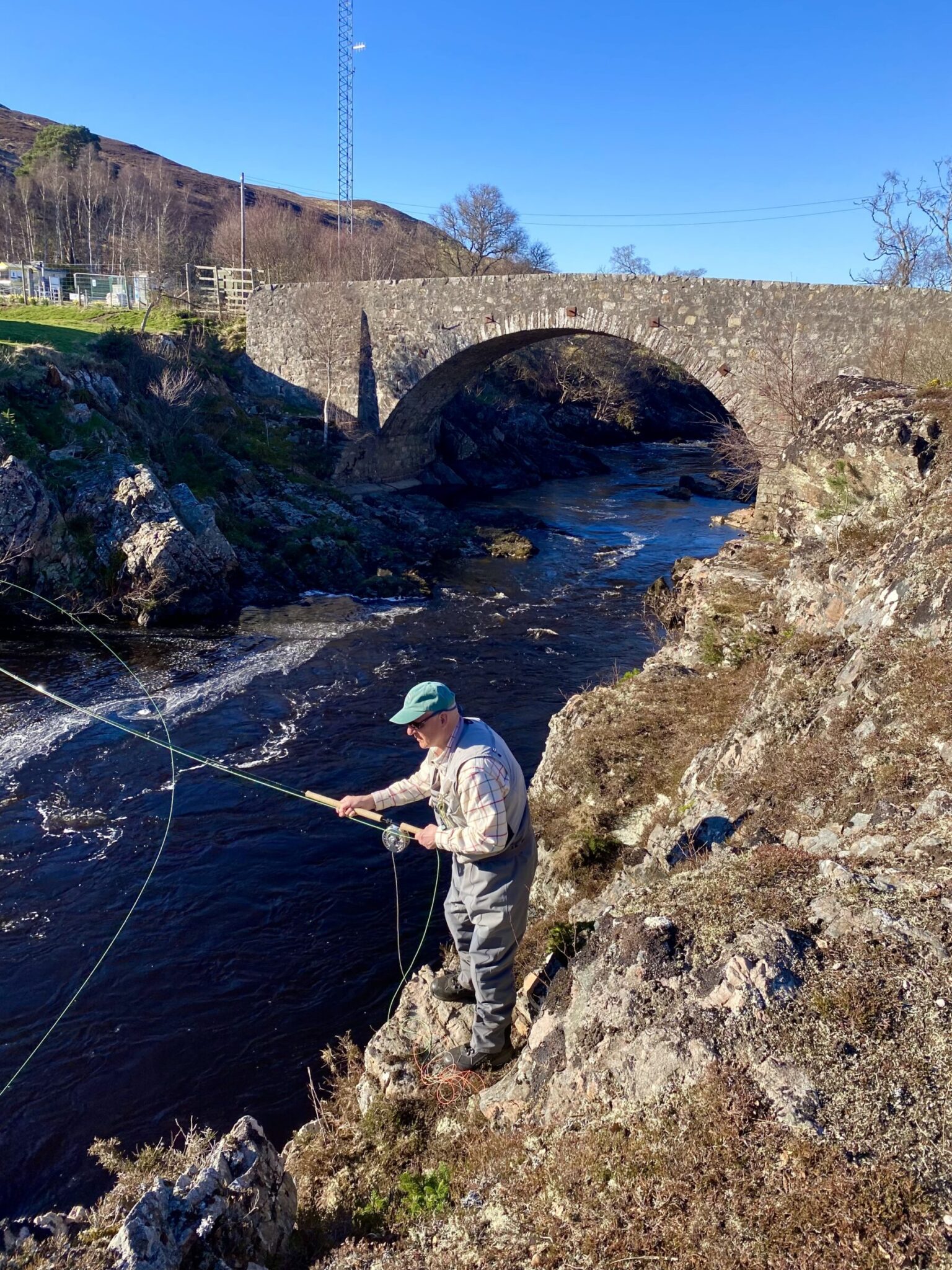
As always, Brad , a very informative and interesting blog! Congrats on your fish in Scotland.
For the first time in 40 +years the Messler Salmon camp in Mcnamee will not be spring fishing! Our group of 8 anglers last fall landed one grilse! We’re going to give it a rest (some of us will be in Andros chasing bonefish) I can only wonder how many other salmon anglers are not going to be on the river? Our group alone certainly adds thousands of dollars per spring season to the local economy. I do know that our guides (our long time friends) will miss us (not to mention the loss of personal income)- and we will miss them.
Not sure if the government officials realize just how much the Miramichi system adds to the economy?
We applaud your efforts with the pending litigation on our behalf . Thank you!!
We will be on the river again in the Fall.
Hi Brad,
I hope you at least smoked my cigars in celebration of at least being able to fish the full week.
Hey Brad,
Thanks for the report. Glad to hear you encountered some fish and I especially enjoyed hearing about the ghillie!
To your points about Spey line connections, you could go down a rabbit hole with the late Dave Whitlock’s Knotless Connection Kit:
https://davewhitlock.com/shop/zap-glue-knotless-kits/whitlock-knotless-connection-kit-dvd-digital/
I have not tried this personally but this kit specifically talks about fly line to shooting line connections. That said, you may have to do some R&D, given the large diameters of the various Spey lines. I’m fairly certain that to do this technique, you want/need a braided core fly line/Spey head. Let me know what you learn!
Cheers,
Jesse
Thanks Jesse. I’ll look at Whitlock’s kit. I have had good results over the years making this connection with braided mono and pliobond also. I’ve got some time to play around with it.